7 Steps to Launch a Product Through Social Media
in Marketing by Anastasiia Holovnenko

In contrast to B2C, which could mean placing an ad on TV or a billboard on the streets, a B2B product launch requires much more effort: conferences, email marketing, direct mail, and call campaigns. Regardless, thanks to the evolution of social media, you can now launch your product or service entirely online.
Social media platforms are places of leisure, fun, communication, and business. Combining these elements into a product launch can provide brand awareness, community engagement, and new opportunities for your business.
However, with so many social media sites out there, which ones do you choose to ensure an effective campaign? In this guide, we’ve gathered the seven most important steps for a successful social media product launch, extra tricks, and examples for inspiration.
The Impact of Social Media in B2B Lead Generation
The B2B decision-making process involves a great deal of trust. Prospects want to be sure that the solution they are acquiring will efficiently solve their needs. Because of the high-complexity nature of a B2B deal, advertisers and vendors must leverage social media as a way to prove their level of commitment to clients.
The B2B buyer's current journey shows that potential buyers wish to conduct their own research about solution providers almost independently. For this reason, social media profiles must provide prospects with relevant information about the brand, how the product works, and how customers feel about their purchases.
Social media platforms also provide vital communication channels. Direct messages not only allow possible buyers to solve their queries about the product but also offer community managers the opportunity to start a personalized conversation with prospects, gather first-hand data, and enter warm leads inside sales pipelines.
Additionally, B2B outbound social media integrations have opened a unique window of opportunity for both customers and vendors. As the first group actively searches for a solution, the second can dissect the prospect's most-used keywords, consumed content, and other intent data options to provide a tailor-made service.
These facts and many more have established social media as one of the most crucial tools for present-day B2B marketing. By correctly identifying what types of prospects utilize what social media and with what purpose, it is possible to engage the decision-makers who crave a fast-paced resolution.
Let's take a closer look at some of the most essential steps to launch a successful B2B social media campaign.
Social Media Product Launch: 7 Steps
When you plan social media posts for a product launch, there are a bunch of details you have to consider: target audience, timing, tactics, strategies, type of platform, and much more. Follow these steps to go through this process without any complications:
1. Determine goals.
Any new business process should first define the destination it wants to reach. When you have a new product or service to launch, you obviously want as many people as possible to know about it. But what else?
Do you want to increase sales, website and page visits, or new subscribers to your newsletter, or is your social media just a part of the brand awareness you want to create? All of these are feasible parameters to set the direction for your campaign and also track its efficiency.
2. Define the timeline.
There are several phases of your social media product launch that include various activities: preparation/pre-launch, launch day, and post-launch. But first, you’ll need to establish a proper timeline to execute each phase successfully.
During this step, outline approximately how much time you need for every activity in your launch campaign and how much time you actually have. This will set the tempo of preparation, ensure minimal conflict with other social media activities, provide deadlines for your team members, and help coordinate efforts between departments.
3. Identify what platforms you want to use.
One of the benefits of digitalization is the vast array of social media platforms you can utilize for your product launch. You may think that the more platforms you use, the better; however, it’s more important to focus on the audience you want to attract.
Consider these social media platforms based on your target audience:
- Twitter: Best for reaching younger audiences (millennials and Gen Z) using hashtags and trends
- LinkedIn: Best for B2B audiences, business networking, and reaching industry leaders
- YouTube: Best for interactive product launches that target niche audiences
- Facebook: Best for mixed audiences that are united by an interest in groups
- Instagram: Best for mixed audiences that can be reached through hashtags and personalized ads
Start by rolling out your new product on a primary social media platform first and then adding a couple more based on your campaign objectives.
4. Prepare the content needed.
First, think about the general tone and vibe you want to get from your content: Do you want it to completely match your usual corporate style or step toward something different? Either way, you should have your content team fully prepared to move on all fronts.
After that, you can host a brainstorming session where the team can come up with concepts and guidelines for your social media product launch. What colors should you use for imaging? What hashtags would generate the most attention? What written content do you need to support the visuals?
During this step, clearly communicate content goals with creators: how many blogs and images are needed, what keywords to use, how long videos should be, and what call to action you need.
5. Prepare a calendar.
Now that you know the time limits of the campaign, what platforms you’ll be using, and the content needed, you can compile those elements into one detailed social media product launch calendar.
It should clearly show what content goes out on what day and time, and on which platform. You’ll also want to leverage your leaders (CEO, CMO, VP, etc.) in social media and include separate slots for them in the calendar as well.
You can make it as extensive as you want, but besides the date, time, and platform, you should include the type of content and necessary links (to websites or folders with content needed).
6. Be ready for launch.
Right before the launch day, check if all the other web assets you possess are in tip-top shape. Launching a product will generate extra activity, and prospects will be checking out not only the new product but also your blogs, website, and social media pages.
If you’ve thoroughly gone through all the previous steps, then on launch day, there shouldn’t be too much hassle. You’ll just need to do quick double-check of content, click “post,” monitor the engagement, and interact with your audience.
It’s also helpful to host a live Q&A (on Facebook or Instagram) to support the launch.
7. Track your success.
Launching a product won’t take one day; it’s a work in progress. Continue to check if the engagement is going the way you expected.
To discover that, track visible KPIs like click ratio, form submissions, comments, likes, or reposts. And if something didn’t go exactly to plan, don’t despair—note it, improve it, and use this experience to make the next campaign even better.

6 Tricks for a Successful Social Media Product Launch
Besides going through all the necessary preparation stages, there are several tactics you can utilize to ensure a successful campaign:
1. Create a hashtag.
A hashtag has a purely practical use: All of the content in your campaign can be united by it and found in one click. It can also be used as the slogan for your campaign to help people spread the word about your new product or service. Your hashtag should be unique, simple, and easy to remember.
2. Drop a teaser.
Nothing stirs up the attention better than a carefully crafted sneak peek into something that is not yet publicly available. It could be an intriguing video, a cryptic image, or a series of posts with product details.
3. Leverage your workers.
Hopefully, most of your employees are following your company on social media. Promote your upcoming launch in the inner chats and encourage them to like, comment, and share. Also, make sure to utilize your C-level executives who have a social following of their own.
4. Use ads.
Although you could try influencer ads and encourage by word of mouth, social media ads are the most efficient option out there. Programmatic ads are cost-effective, easy to implement, and thanks to machine learning and AI technologies, bring highly targeted results.
5. Launch a countdown.
A countdown is not just a clock to show the time that passes; it’s also a series of posts supporting the anticipation and preparing your audience for the big event.
6. Engage with the audience.
Everything you do during a social media product launch is meant to engage your audience in one way or another. To maximize those efforts, add quizzes, surveys, and even contests. Start as many conversations as possible: Ask questions, tag people, and reply to every comment.
10 Social Media Product Launch Examples
Lots of brands already use social media posts for a marketing product launch. Here are some of the most impressive examples for your inspiration:
1. MIIR
This is a simple and traditional yet very effective strategy for MIIR’s new sustainable drinkware product. The image captures the attention with a minimalistic intro while the text introduces the product point by point.
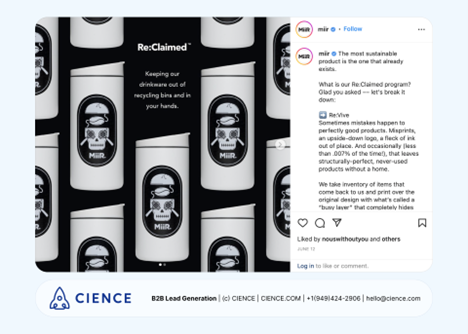
Source: MIIR
2. Cisco
Cisco, a cybersecurity company, had a social media campaign where it created an actual graphic novel on the importance of cybersecurity in six languages. It got them a lot of reposts, shares, and new opportunities.

Source: Cisco
3. Olipop
Olipop chose a double promotion: They designed a drink in collaboration with the movie Minions. They use a well-known brand and the wording is on point, which brings attention to the drink and promotes the movie at the same time.
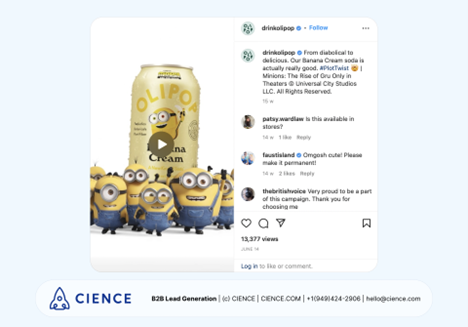
Source: Olipop
4. Slack
The Slack messaging app is a great example of how you can implement a lot of different strategies into your social media profile to drive engagement and successfully introduce new products. They start conversations, give tips, and in this example, promote a feature through the user review from a Spotify worker.
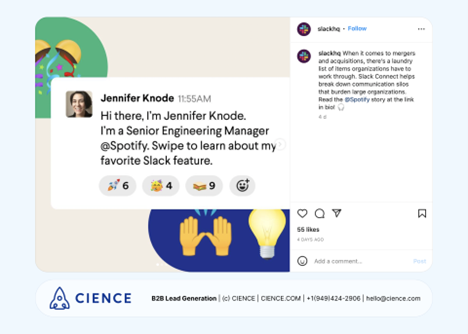
Source: Slack
5. Apple
Of course, everyone knows Apple. So instead of investing in long videos, the company decided to simply show the value that its new product brings to the table with this image.
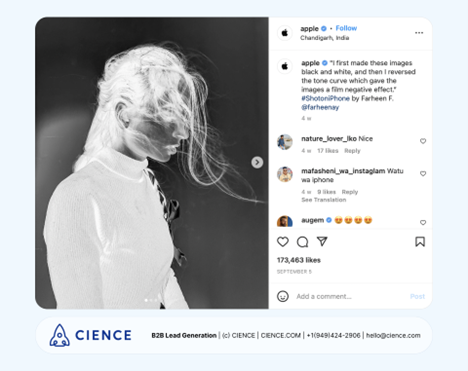
Source: Apple
6. Kroger
Kroger, grocery retail company, hit the spot here in more than one way: It used a hashtag, appealed to the current day, engaged the audience in a contest, promoted some of their foods, and even had a funny contribution in the comments.
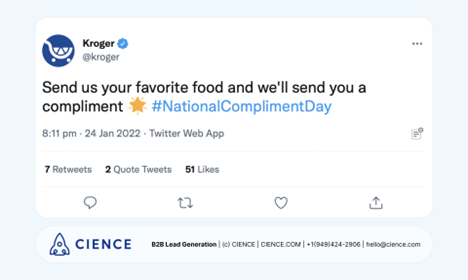
Source: Kroger
7. Mailchimp
In a series of Facebook posts labeled “Power Partners,” Mailchimp used successful cooperations and partnerships to clearly show the effect that their service provided.

Source: Mailchimp
8. CIENCE
During the launch of its GO Data products, CIENCE Technologies introduced lots of thematic articles and the CMO promoted the product using a hashtag and a personal recommendation.
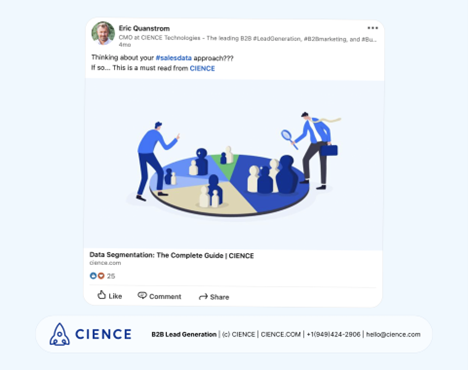
Source: CIENCE
9. IBM
What’s a better way to prove your worth than to provide statistics that back it up? That’s what IBM did, promoting a survey that shows the need for its hybrid cloud service.
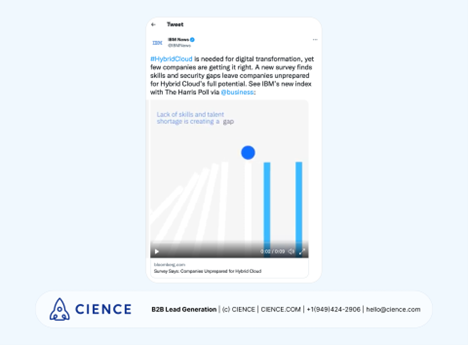
Source: IBM
10. Upwork
Upwork created an ad campaign labeled #ThisIsHowWeWorkNow that hilariously highlights how the old ways of working should be long in the ground. The ad campaign presented on Instagram is encouraging decision-makers to utilize remote working and use their platform.
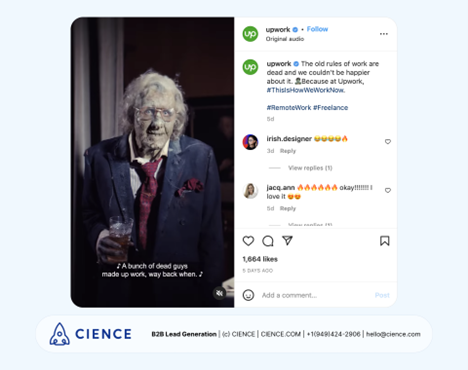
Source: Upwork
Launch Your Product Like a Rocket
Social media offers a reach that no other resource can, especially when it comes to introducing a new product or service to the B2B market. With a great variety of platforms, tactics, and steps that we’ve just introduced, you can find an approach that will boost brand awareness, present your new offer to the audience, and add many new business opportunities into your sales funnel.




